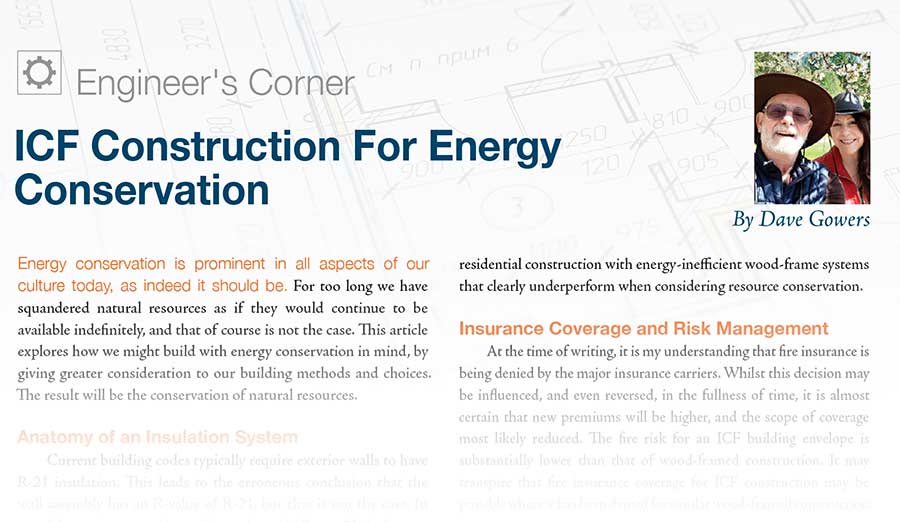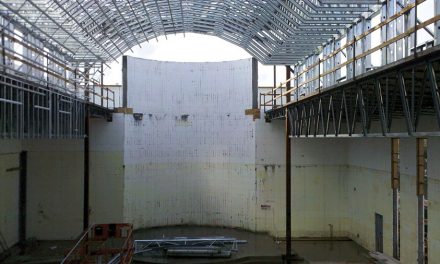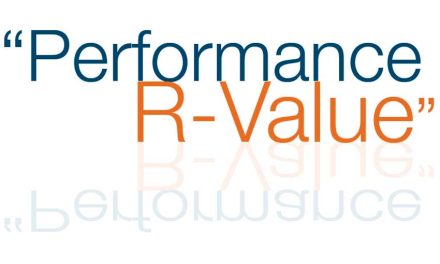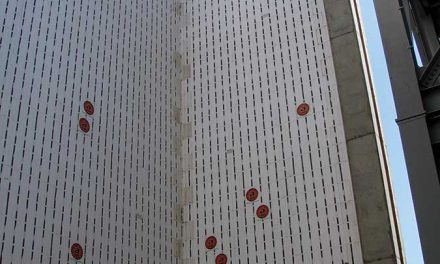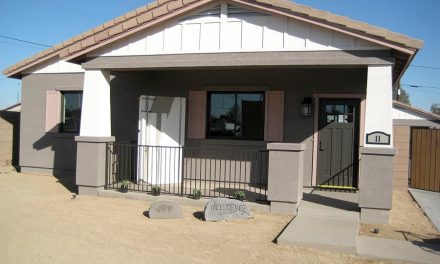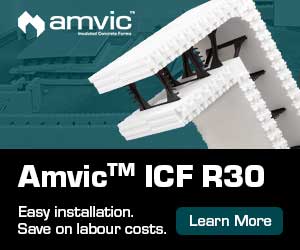By Dave Gowers
Energy conservation is prominent in all aspects of our culture today, as indeed it should be. For too long we have squandered natural resources as if they would continue to be available indefinitely, and that of course is not the case. This article explores how we might build with energy conservation in mind, by giving greater consideration to our building methods and choices. The result will be the conservation of natural resources.
Anatomy of an Insulation System
Current building codes typically require exterior walls to have R-21 insulation. This leads to the erroneous conclusion that the wall assembly has an R-value of R-21, but that is not the case. In wood-frame construction, with studs typically at 16 inches on center, double studs on either side of all openings, a single sill plate, and a double top plate, the actual performance R-value will be less than R-21 for the wall assembly. Calculation will show that this performance R-value is closer to R-17. This is further exacerbated by the fact that batt insulation will actually sag over time, leaving uninsulated cavities at the top of each space between studs.
Compare this to an ICF wall assembly, where the polystyrene foam is continuous from opening to opening, and from the bottom of the sill plate to the top of the roof plate. The calculated R-value of the foam is typically in the range of R-23 to R-25, depending on the ICF system selected. Because of the foam continuity, this is a true performance R-value, which is significantly better than that of wood-framed construction, as described above.
However, it has been shown by rigorous testing* that the thermal mass of the concrete plays a significant part in the performance R-value of the wall assembly, so much so that it might be considered as high as R-40! This leads to a colossal difference in energy conservation!
Code Position on Energy Conservation
Building codes are being continually upgraded each three-year code cycle to reflect the energy requirements and recommendations of the sister energy codes. The 2024 International Energy Conservation Code recognizes that discontinuous insulation should be bolstered with added continuous rigid foam insulation across the framing, to ensure that R-value ratings are truer to that expected. The USA has adopted the International Code series as its base, but each state will select the parts of the I-codes that they will adopt. Also, it might take two to three code cycles before the I-code recommendations are adopted. In the meantime, we continue to build 80% of new residential construction with energy-inefficient wood-frame systems that clearly underperform when considering resource conservation.
Insurance Coverage and Risk Management
At the time of writing, it is my understanding that fire insurance is being denied by the major insurance carriers. Whilst this decision may be influenced, and even reversed, in the fullness of time, it is almost certain that new premiums will be higher, and the scope of coverage most likely reduced. The fire risk for an ICF building envelope is substantially lower than that of wood-framed construction. It may transpire that fire insurance coverage for ICF construction may be possible where it has been denied for similar wood-framed construction.
Indoor Environmental Quality
Many of us spend up to 90% of our lives indoors, which means the quality of indoor air is as important to our health as is the quality of outdoor air. ICF construction typically produces a much tighter building envelope when compared with wood-frame construction. This in turn allows for tighter control of the IEQ, with a reduced energy demand, thus conserving natural resources.
Building Costs, Labor & Material Resources
The recent colossal tragedy of the Los Angeles fires is still being evaluated with regard to rebuilding in the most efficient manner possible. With the order of 12,000 structures destroyed, including residences, schools, retail premises, etc, the logistics of rebuilding is mind-boggling. I’ve recently learned that if a homeowner chooses to build a residence of the same size or no more than a 10% increase on what previously existed, Los Angeles County has instigated a fast-track process. Unfortunately, there are no less than 12 government agencies that have to be solicited to determine the extent of their respective involvement in the fast-track process. On the premise that everything proceeds and complies with this process, new residential construction has to be EV car–ready, and fully electric-ready. This means that Los Angeles County is preparing for all new construction to be electricity dependent.
It has never been more important that new construction should be the most energy-efficient possible, and that points strongly in the direction of ICF construction. The trueness of construction is also an issue—the quality of framing lumber continues to decline, whereas the quality of ICF products is consistent both with regard to material quality and dimensional trueness. Another aspect of the massive L.A. rebuilding is the availability of material and labor. There is already a shortage of framers nationwide, so the labor demand for the L.A. County rebuild will be extreme. It is far easier and quicker to train ICF installers than it is to train framers.
Operating Expenses
One area where ICF construction excels is the lifetime operating costs. Quoting from the Thermal Performance of ICF Walls, reference 1, “it should be noted that ICF walls … perform better than cavity walls, maintain their R-value over time, and consistently resist temperature fluctuation because of stored energy. ICF structures require less overall energy to heat or cool … with less cost to the end user.”
Repairs and Maintenance
Once built, the ICF building envelope will be virtually maintenance-free for many years to come. This is not the case with wood-framed construction, which is immediately susceptible to mold, rot, and decay within a relatively short time frame. In wet climates such as Oregon, it is not uncommon to see a fully-framed wood-frame structure totally exposed to the elements. Even though the contractor might make much effort to dry the structure once it is weathered in, one might question whether mold has already started to form.
Disaster Resistance
The rebuild cost incurred in the aftermath of a major disaster is colossal! Frequently, the only structures left standing in areas affected by wildfires and hurricanes are those of ICF construction! Imagine the monumental cost and energy savings that would be achieved if all structures were built with ICF!
Conclusion
In conclusion, ICF construction is an excellent choice for building with an emphasis on energy conservation. The construction process itself will be more energy-efficient due to the conservation of resources, but the operating cost savings will continue for the life of the structure, reaping the benefit of continually preserving resources that have a diminishing finite availability.
*Thermal Performance of ICF Walls, by Micah Garrett, Chairperson ICFMA Education Committee, ICF Builder Magazine, May/June 2020; https://www.icfmag.com/2020/05/lab-notes-thermal-performance-of-icf-walls
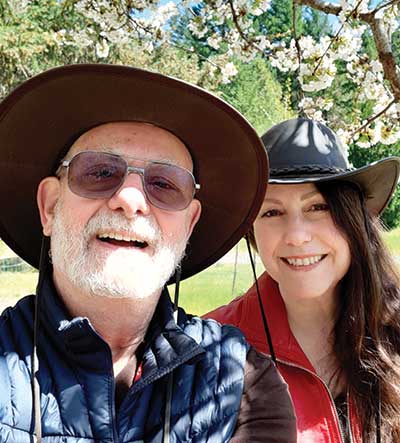
Dave Gowers
In the 51 years since graduating from London University in the United Kingdom, Dave Gowers has acquired extensive experience in concrete construction through diverse commercial, residential, and industrial projects, up to $1 billion in value, in several countries. Dave resides in Southern Oregon with his wife and business partner, Jennifer. Dave holds a PE license in 14 states/territories and is the principal of Dave Gowers Engineering LLC and co-principal of Cascade ICF LLC. He can be reached at 541-660-9661 or dave@dgengineering.com.

